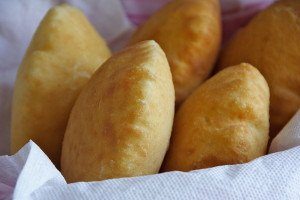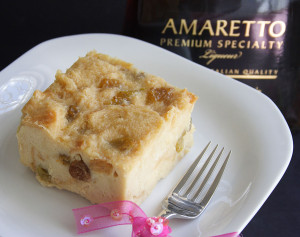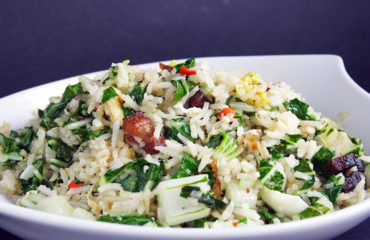Eat Local – Create Taste Mmm…memories

By Cynthia Nelson
When choosing the locale for your Caribbean destination wedding, be sure to take in one of the most important cultural aspects of the country: the food! There is much to explore and sample, so be sure to pick your favourites and let them be deliciously reflected in your menu.
You’ll quickly realise how similar our food is across the Caribbean states. There are certain dishes that you’ll find throughout the region, with signature twists added by each country to make it their own.
Rice ‘n Peas, Macaroni Pie, Stews, Curries, Ground Provisions, Fried Bakes, and Fried (sautéed) Salt Fish are among the dishes we all share. But, the differences in these dishes across countries stem from both the preparation and names given. For example, ‘bakes’ are also known as “Johnny Cakes” in Jamaica, Anguilla, and St. Croix, while Grenadians and St. Lucians call them “floats”. These irresistible little breads are further categorized into “fried bakes”, “roast bakes” and even “baked bakes”.
So, as you travel across the region to celebrate your special day, be sure to enjoy some of the local fare for unforgettably tasty memories!
Cynthia Nelson is a Journalist, Author & Photographer. Tastes Like Home – My Caribbean Cookbook (IRP 2010). She blogs at: www.tasteslikehome.org Write to her at: Cynthia@tasteslikehome.org
Recipes
Bakes/Floats
Yield: 1
INGREDIENTS
- 3 cups all purpose flour
- 3 teaspoons baking powder
- ½ teaspoon salt
- 1 tablespoon sugar
- ¼ teaspoon ground cinnamon
- 1 tablespoon butter (salted or unsalted)
- 1 ¾ cups lukewarm water to knead dough
- Neutral-tasting oil for deep-frying
DIRECTIONS
- Mix the flour, baking powder, salt, sugar, and cinnamon in a large bowl.
- Rub butter into flour mixture.
- Add water to the flour mixture to make dough. Do not add all of the water at the same time. (Amount of liquid needed varies according to the composition of flour and temperature of surroundings.) Start with 1 ¼ cups and work your way up from there. When the dough comes together, knead for 2 – 3 minutes.
- Place dough in a lightly oiled bowl. Rub some oil over the dough and cover with plastic wrap. Let dough rest for at least 30 minutes, but no longer than 1 hour.
- Cut dough into 12 equal pieces and form into balls. Cover and let rest for 10 minutes.
- Line a large bowl with a kitchen towel as well as some paper towels.
- Heat oil in deep pan on medium heat until hot. Test the oil by breaking off a piece of dough and adding it to the oil; if it sinks and rises almost immediately, the oil is ready. If you have a thermometer, it should register at 325 degrees F.
- Lightly flour a work surface and rolling pin. Take one piece of dough and roll into a disc: about 3 inches diameter and ¼-inch thick.
- Add to the hot oil and fry until browned on both sides. (Once added to the oil, the bake initially sinks, but floats to the surface as it puffs and cooks. Flip the bake over and cook the other side.) Reduce heat if bakes are browning too quickly before the insides are cooked.
- Repeat steps 8 and 9 above until all the bakes are fried.
- Serve the bakes warm. Cut along the sides of the bake to create a pocket and fill with fried (sautéed) salt fish, smoked herring, cheese, ham, or fried fish. Or, cut open completely and slather with your favourite topping.
Fried (Sautéed) Salt fish

Note: This recipe requires overnight preparation before cooking
Yield: 3 cups
INGREDIENTS
- 10 ounces de-boned or boneless salt fish
- Water
- 3 tablespoons oil
- 1½ cups thinly sliced onions
- 2 sprigs fresh thyme
- Finely minced hot pepper to taste
- 1 cup chopped tomatoes
- ¼ teaspoon salt
- Black pepper to taste
DIRECTIONS
- Night before cooking: Rinse the fish and add to a large bowl of very hot water. Cover bowl and let fish soak overnight.
- Next day: Drain fish and add to a pot of water on the stove. Let boil for 6 – 8 minutes. (The key here is to remove only the salt that is in excess, not all of it. Taste a small piece of the fish; it should not be overly salty.)
- Drain the cooked fish well. When cool enough to handle, crumble into small pieces.
- Heat the oil in a pan until hot, but not smoking. Add onions and sauté until translucent, about 2 – 3 minutes.
- Add thyme and hot pepper and continue to cook for another minute.
- Add tomatoes, salt, and black pepper and cook for a minute.
- Add salt fish and cook partially covered for 5 – 7 minutes.
- Serve with bakes, roti, rice, bread, or ground provisions.
Punch de Crème Bread Pudding
Yield: 1 (9 x 13) dish
NOTES
- You will need a large roasting pan in which the 9 x 13 dish can sit comfortably for a hot water bath (bain marie).
- Baking the pudding directly in its dish is also fine. The top, bottom and edges will get brown and crusty, which is quite yummy. However, the look and texture of the baked pudding will be different from the one that has been cooked gently and indirectly in the hot water bath.
- For the bread pudding to truly absorb the custard, it must soak in the mixture for at least 6 – 8 hours. Overnight is ideal. This long period of absorption will also improve the texture of the bread pudding when baked.
- Bread rolls (such as tennis rolls) can be used in place of regular bread. To get the true Punch de Crème flavour, I would advise against using breads or rolls that are already flavoured or spiced.
INGREDIENTS
- Punch de Crème (recipe follows)
- 8 cups cubed bread (preferably 1 – 2 days old)
- ½ cup golden raisins (sultanas)
- 2 tablespoons melted butter (preferably unsalted)
- Boiling water
For Punch de Crème:
- 6 eggs
- 3 cans full cream evaporated milk
- 2 cans condensed milk
- 2 teaspoons Angostura Bitters
- 1 ¼ cups dark rum or more to taste
- ½ teaspoon freshly grated nutmeg
- Zest of two limes (substitute with orange)
DIRECTIONS
For Punch de Crème:
- Add eggs and lime zest and whisk until frothy.
- Add evaporated milk, condensed milk, bitters, nutmeg, and rum. Whisk to incorporate.
For bread pudding:
- Add the bread to a large bowl or container.
- Pour the Punch de Crème over the bread. Using a large spoon or spatula, keep pressing the bread into the custard until the bread is heavy with the liquid. Cover the bowl and refrigerate overnight.
- When you are ready to bake the bread pudding, remove from refrigerator and let it come up to room temperature.
- Scatter and fold in the raisins.
- Meanwhile, put a kettle of water on to boil.
- Preheat oven to 350 degrees F.
- Brush the 9 x 13” baking dish with the melted butter, and then pour the bread pudding mixture into the dish. Place dish with the bread pudding in the larger roasting pan for the hot water bath.
- This step of adding hot water to create the bath can be done in two ways:
- Pour the boiling water into the roasting pan on the countertop and then carefully transfer the pan and dish to the oven, or
- Place the roasting pan (containing the dish of bread pudding) in the oven and then carefully pour the boiling water into the roasting pan. Let the water come halfway up the sides of the dish with the bread pudding.
- Bake for 50 – 60 minutes, or until a knife inserted comes out clean.
- Remove roasting pan from the oven and wait about 20 minutes for the water to cool. Remove dish with the bread pudding and place on a wire rack to continue cooling. Serve warm, at room temperature, or cold. (Note: If you want to add more booze to this bread pudding, then serve drizzled with Amaretto liqueur.)





